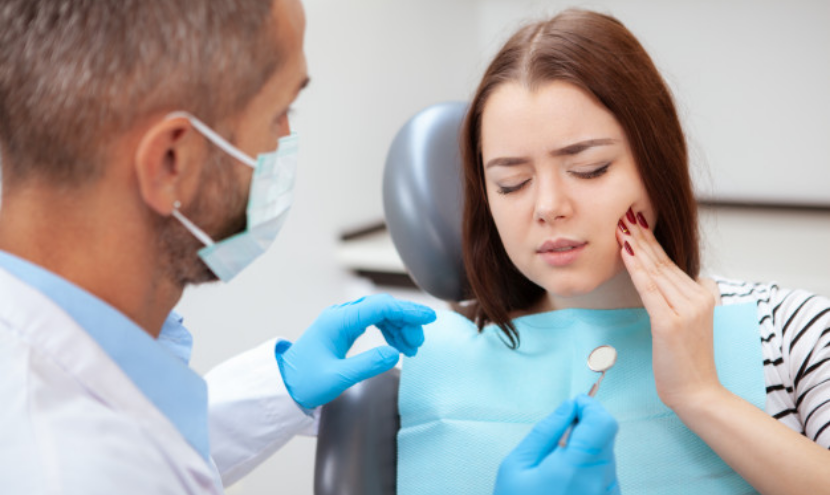Dental emergencies are frightening, and sometimes painful. To relieve discomfort and ensure the teeth have the highest possible chance of survival, timely care is always essential.
Occasionally, teeth get broken by scratching, scraping or chewing on hard surfaces. In other situations, they can get damaged by fillings, crowns, and other restorative devices, or fully fall out of the mouth. If there is extreme pain, it is important to make an appointment as soon as possible with the dentist. Without care, the pain caused by dental emergencies often gets worse and dental complications can seriously endanger physical health.
Types of dental emergencies and how to treat them
A knocked out tooth
When a tooth is knocked out of the mouth, having a dentist immediately is important. Once a tooth is knocked out, it affects the gums, nerves and blood vessels. If the tooth can be placed back in its socket within an hour, then there is a possibility that the tissues can expand again to support the tooth.
Here are a few steps to follow:
- Call the dentist.
- Rinse the tooth by the crown under warm water. DO NOT touch the root.
- Place it back in its socket if necessary.
- When the tooth can not be put in the mouth, as a last resort, place the tooth in a cup of milk,saliva, or water. It ‘s critical that the tooth does not dry out.
- Get to dentist, quick.
- In his normal hole, the dentist must primarily try to restore your tooth. In some cases, the tooth may re-attach, but if the teeth ‘s internal structures are seriously damaged, root canal therapy may be required.
Lost filling or crown
A crown or filling usually comes loose when eating on tough surfaces or due to a dental injury. Once out of the mouth, the affected tooth may be highly sensitive to changes in temperature and pressure. Crowns typically become loose as the underside of the tooth decays. The decay induces changes in the shape of the teeth – which means the crown no longer fits.
If a crown falls from the mouth, start making a dental appointment as early as possible. Keep the crown in a clean, safe place, because the dentist may be able to reinsert it. If the crown is long out of the mouth, the teeth can move or suffer further damage.
Here are the steps to take when the dentist is not immediately accessible:
- To soothe pain, put some clove oil to the tooth.
- Restore the crown and place it back with dental cement onto the tooth. This can be acquired at the local pharmacy.
- DO NOT use any form of glue to add crown.
The dentist tests the crown to see whether it still fits. If it does, it is connected to the tooth again. In some cases, you might need a new crown, for which you need to undergo a dental crown procedure. This will be done where decay is noted and a new crown will be made.
Teeth missing or damaged
The teeth are sturdy but still vulnerable to fractures, cracks, and breaks. Fractures are sometimes fairly painless, but if the fracture reaches down to the root, the pain is likely to be severe. Fractures, cracks, and breaks can take various forms, but are usually caused by rubbing, grinding, and biting. There is no alternative to seeing the dentist as quickly as possible if a tooth has been broken or cracked.
Where a tooth fragment has been broken off, here are some steps you can take at home:
- Call the dentist.
- Rinse with lukewarm water on the tooth fragment and lips.
- If bleeding is present, apply gauze to the area for ten minutes.
- Hold a cool, damp dishtowel on the cheek to alleviate pain and swelling.
- When there is no way to see the dentist immediately, cover the affected area with over-the-counter dental adhesives.
- Take a pain reliever.
The essence of the crack or fracture will limit what the dentist can do. When a fracture or crack grows into the root, root canal therapy may be the only reliable way of retaining the tooth. In the event of a complete split, the dentist will usually add the fragment back as a temporary measure to restore the tooth.
Dislodged / loose teeth
It could be rescued if a tooth has been displaced or loosened from its socket by damage or decay. If the tooth stays in the mouth and attached to the blood vessels and nerves, there is no need for a good chance of root canal therapy.
To make an appointment, it is necessary to call the dentist immediately. In the meantime, use over-the-counter and cold compress drugs to relieve pain. The dentist must reposition the tooth and apply splints to keep it secure. If the tooth is not healing, it may need root canal therapy.
Please contact your emergency dentist in Jacksonville FL if you have any questions or concerns about any dental emergencies. We are open for all sorts of dental emergencies with the highest safety standards amid COVID-19.

